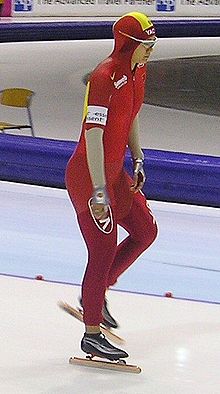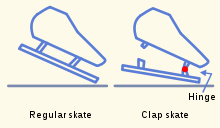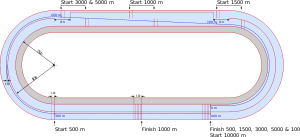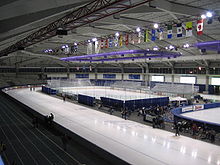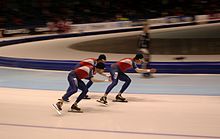- Long track speed skating
-
For related forms of competition, see Speed skating.
Speed skating (also long track speed skating) is an Olympic sport where competitors are timed while crossing a set distance. It is also a sport for leisure. Sports such as short track speedskating, inline speedskating, and quad speed skating are also called speed skating. Long track speed skating enjoys large popularity in the Netherlands and has also had champion athletes from Austria, Canada, China, Finland, Germany, Japan, Italy, Norway, South Korea, Russia, Sweden, the Czech Republic and the United States. Speed skaters attain maximum speeds of up to 65 to 70 km/h (40 to 43 mph).
Contents
History
ISU development
 Jaap Eden, the first official world champion
Jaap Eden, the first official world champion
Organized races on ice skates first developed in the 19th century. Norwegian clubs hosted competitions from 1863, with races in the town of Christiania drawing five-digit crowds.[1] In 1884, the Norwegian Axel Paulsen was named Amateur Champion Skater of the World after winning competitions in the United States. Five years later, a sports club in Amsterdam invited to an ice skating event they called a world championship, with participants from Russia, the United States and the United Kingdom, as well as the host country. The Internationale Eislauf Vereinigung, now known as the International Skating Union, was founded at a meeting of 15 national representatives in Scheveningen in 1892, the first international winter sports federation. The Nederlandse Schaatsrijderbond was founded in 1882[2] and organised the world championships of 1890 and 1891.[3]
Competitions were held around tracks of varying lengths—the 1885 match between Axel Paulsen and Remke van der Zee was skated on a track of 6/7 mile (1400 metres)—but the 400-metre track was standardised by ISU in 1892, along with the standard distances for world championships, 500 m, 1500 m, 5000 m, and 10,000 m. Skaters started in pairs, each to their own lane, and changed lanes for every lap to ensure that each skater completed the same distance. Competitions were exclusively for amateur skaters. Peter Sinnerud was disqualified for professionalism in 1904 and lost his world title.
World records were registered since 1891 and improved rapidly: Jaap Eden lowered the world 5000-metre record by half a minute during the Hamar European Championships in 1894. The record stood for 17 years, and it took 50 years to lower it further by half a minute.[4]
Elfstedentocht and Dutch history
The Elfstedentocht was organised as a competition in 1909 and has been held at irregular intervals whenever the ice on the course is deemed good enough. Other outdoor races developed later, with Noord-Holland hosting a race in 1917, but the Dutch natural ice conditions have rarely been conducive to skating. The Elfstedentocht has been held 15 times since 1909, and, before artificial ice was available in 1962, national championships had been held in 25 of the years between 1887, when the first championship was held in Slikkerveer, and 1961. Since artificial ice became common in the Netherlands, Dutch speed skaters have been among the top long track speed skaters and marathon skaters in the world.
Another solution to still be able to skate marathons on natural ice became the Alternative Elfstedentocht. The Alternative Elfstedentocht races take part in other countries, such as Austria, Finland or Canada, and all top marathon skaters as well as thousands of recreative skaters travel from the Netherlands to the location where the race is held. According to the NRC Handelsblad journalist Jaap Bloembergen, the country "takes a carnival look" during international skating championships, despite the fact that "people outside the country are not particularly interested."[5]
Olympic Games
At the 1919 Olympic Congress, the delegates agreed to include long track speed skating in the 1916 Olympics, after figure skating had featured in the 1908 Olympics. However, World War I put an end to the plans of Olympic competition, and it was not until the winter sports week in Chamonix in 1924—retroactively awarded Olympic status—that ice speed skating reached the Olympic programme. Charles Jewtraw from Lake Placid, New York, won the first Olympic gold medal, though several Norwegians in attendance claimed Oskar Olsen had clocked a better time.[6] Timing issues on the 500 m were a problem within the sport until electronic clocks arrived in the 1960s; during the 1936 Olympic 500-metre race, it was suggested that Ivar Ballangrud's 500-metre time was almost a second too good.[7] Finland won the remaining four gold medals at the 1924 Games, with Clas Thunberg winning 1,500 metres, 5,000 metres, and allround. It was the only time an allround Olympic gold medal has been awarded in speed skating.
Norwegian and Finnish skaters won all the gold medals in World Championships between the world wars, with Latvians and Austrians visiting the podium in the European Championships. At the time, North American races were usually conducted packstyle, similar to the marathon races in the Netherlands, but the Olympic races were to be held over the four ISU-approved distances. The ISU approved the suggestion that the 1932 Olympic speed skating competitions should be held as packstyle races, and Americans won all four gold medals. Canada won five medals, all silver and bronze, while defending World Champion Clas Thunberg stayed at home, protesting against this form of racing.[8] At the World Championships held immediately after the Games, without the American champions, Norwegian racers won all four distances and occupied the top three spots in the allround standings.
Norwegian, Swedish, Finnish and Japanese skating leaders protested to the USOC, condemning the manner of competition, and expressing the wish that mass start races were never to be held again at the Olympics. However, ISU adopted the short track speed skating branch, with mass start races on shorter tracks, in 1967, arranged international competitions from 1976, and brought them back to the Olympics in 1992.
Women's competitions
In the 1935s, women began to be accepted in ISU speed skating competitions. Although women's races had been held in North America for some time and competed at the 1932 Winter Olympics in a demonstration event, the ISU did not organise official competitions until 1936. However, Zofia Nehringowa set the first official world record in 1929. Women's speed skating was not very high-profile; in Skøytesportens stjerner (Stars of the skating sport), a Norwegian work from 1971, no female skaters are mentioned on the book's nearly 200 pages, though they had by then competed for nearly 30 years. The women's long track speed skating was since dominated by East Germany and later reunified Germany, who have won 15 of 35 Olympic gold medals in women's long track since 1984.
Technical developments
Artificial ice entered the long track competitions with the 1960 Winter Olympics, and the competitions in 1956 on Lake Misurina were the last Olympic competitions on natural ice. 1960 also saw the first Winter Olympic competitions for women. Lidia Skoblikova won two gold medals in 1960 and four in 1964.
More aerodynamic skating suits were also developed, with Swiss skater Franz Krienbühl (who finished 8th on the Olympic 10,000 m at the age of 46) at the front of development.[9] After a while, national teams took over development of "body suits". Suits and indoor skating, as well as the clap skate, has helped to lower long track world records considerably; from 1971 to 2007, the average speed on the men's 1500 metres was raised from 45 to 52 km/h (28 to 32 mph). Similar speed increases are shown in the other distances.
Professionalism
After the 1972 season, European long track skaters founded a professional league, International Speedskating League, which included Ard Schenk, three-time Olympic gold medallist in 1972, as well as five Norwegians, four other Dutchmen, three Swedes, and a few other skaters. Jonny Nilsson, 1963 world champion and Olympic gold medallist, was the driving force behind the league, which folded in 1974 for economic reasons, and ISU also excluded tracks hosting professional races from future international championships.[10] The ISU later organised its own World Cup circuit with monetary prizes, and full-time professional teams developed in the Netherlands during the 1990s, which led them to a dominance on the men's side only challenged by Japanese 500 m racers and a couple of American allrounders.
Racing
All races are held in pairs, for which two lanes on the track are used. Skaters wear bands around their upper arm to identify which lane they started in. The colours are white for inner lane and red for outer lane. At the back straight, the skaters switch lanes, which causes them both to cover the same distance per lap. When both skaters emerge from the corner at exactly the same time, the person currently in the inner lane will have to let the outer lane pass in front of him. This usually does not cause any problems, as the person in the outer lane will generally move much faster than the person in the inner lane.
Occasionally, quartet starts are used, for the pragmatic and practical reason of allowing more skaters to complete their races inside a given amount of time. This involves having two pairs of skaters in the lanes at the same time, but with the second pair starting when the first have completed approximately half of the first lap. The skaters in the second pair will then wear yellow and blue arm bands instead of the usual white and red.
Rink
See also: Speed skating rinkSkaters race on a two-lane oval rink similar in dimension to an outdoor athletics track. Indeed, an athletics track covered with ice can function as a speed skating track, such as Bislett stadion in Oslo up to the 1980s. According to the rules of the International Skating Union, a standard track should be either 400 m or 333⅓ m long; 400 m is the standard used for all major competitions. Tracks of other, non-standard lengths, such 200 or 250 m, are also in use in some places for training and/or smaller local competitions. On standard tracks, the curves have a radius of 25–26 m in the inner lane, and each lane is 3–4 m wide.
Top international rinks
These rinks have hosted international events (World Cups or international senior championships) between 2005 and 2010.
Indoor
- Gunda-Niemann-Stirnemann-Halle, Erfurt, Germany
- Heilongjiang Indoor Rink, Harbin, China
- Jilin Provincial Speed Skating Rink, Changchun, China
- Kometa Ice Rink, Kolomna, Russia
- Krylatskoye Sport Complex, Moscow, Russia
- M-Wave, Nagano, Japan
- Oval Lingotto, Turin, Italy
- Olympic Oval, Calgary, Canada
- Pettit National Ice Center, West Allis, Wisconsin, United States
- Richmond Olympic Oval, Richmond, British Columbia, Canada
- Sportforum Hohenschönhausen, Berlin, Germany
- Thialf, Heerenveen, Netherlands
- Utah Olympic Oval, Kearns, Utah, United States
- Vikingskipet, Hamar, Norway
- Indoor Speed Skating Rink, Astana, Kazakhstan
Of these, the rinks in Calgary and Kearns are located at a high altitude, which often ensures faster times than lowland rinks due to decreased air resistance[citation needed].
After the completion of the 2010 Olympic Winter Games, the Richmond Olympic oval "...will shed its long track speed skating configuration for a multi-sport layout that will accommodate ice, track, court, paddling and fitness users".[11]
Outdoor
- Ice Rink Pinè, Baselga di Pinè, Italy
- Ludwig Schwabl Stadion, Inzell, Germany
- Ritten Kunsteisbahn, Klobenstein–Collalbo, Italy
- High-altitude skating rink Medeo, Kazhakstan
All four of these are high-altitude rinks.
Equipment
There are primarily two types of skates, traditional ice skates and the clap skates. The clap skates were introduced around 1996 and were a revolution in that they are hinged to the front of the boot and detach from the heel, allowing the skater a more natural range of movement. This enables a longer stroke while keeping maximum contact with the ice. By the 1998 Winter Olympics, nearly all skaters used clap skates.
Both use long and straight blades compared to many other ice skating sports. Blades are about 1 mm thick and typically come in lengths from 13 to 18 inches (33–45 cm). Most competitive athletes use lengths between 15 and 17 inches (38–43 cm), depending on body size and personal preference.
A lot of attention is given to air resistance. The rules demand that the suits follow the natural shape of the body, preventing the use of, e.g., drop shaped helmets (as seen in cycling) or more inventive "Donald Duck" costumes. However, a lot of time and money is spent developing fabrics, cuts and seams that will reduce drag. Some skaters use low (no thicker than 3 mm) "aerodynamic strips" attached to their suits. These are intended to create turbulent flow in certain areas around the body.
Glasses or goggles may also be worn so that the wind does not dry out the eyes.
Competition format
Allround
The oldest competition format still in place is the allround event, standardized in 1892 (see History above). Skaters skate four distances (for men: 500 m, 1500 m, 5000 m, and 10,000 m), and a ranking is made up based on the times skated on all of these distances. The method of scoring is the same for all combinations. All times are calculated back to 500 m times, so skating the 500 m in 40 seconds gives 40 points, while 1500 m (3×500 m) in 2 minutes (120 seconds, equivalent to 3×40 s) also gives 40 points. Points are calculated to three decimal places, and truncation is applied; the numbers are not rounded. The skater who has the fewest points wins the competition. This system is called samalog. An allround champion may often not have won a single distance—such as Viktor Kosichkin in the 1962 World Championship—or he may win three distances but lose the overall title. Originally, three distance victories won one the championship, but the rules were changed after Rolf Falk-Larssen beat Tomas Gustafson at the 1983 World Championship despite having more points.[12] The ISU organizes an annual World Allround Speed Skating Championships.
Sprint championships
The sprint championships are two-day events where skaters run the 500 m and 1000 m on both days. The samalog system is again applied to crown the winner. To counter any systematic bias regarding inner versus outer lanes, skaters change start lanes from the first day to the second. Nations with active skaters arrange annual national sprint championships, and the ISU have been arranging annual World Sprint Speedskating Championships for men and for ladies since 1970. While there are annual European (Allround) Speedskating Championships, no such championships are arranged for the sprinters.
Single distances
A more basic form of speed skating consists of skating a single event. This is the format used for the World Single Distance Championships, which have been arranged since 1996, and the World Cup. The usual distances are the 500 m, 1000 m, 1500 m, 3000 m (ladies only), 5000 m and 10,000 m (men only), but some other distances are sometimes skated as well, such as 100 m and 1 mile. Women occasionally, but rarely, are given the opportunity to skate the 10,000 m, but outside the top-level championships.
The 500 m is usually skated with two runs, so that every skater has one race starting in the outer lane and one in the inner. This practice started with the first of the World Single Distance Championships in 1996, and with the 1998 Nagano Olympics; at all earlier Olympics, the 500 m was skated only once. The reason for skating this distance twice is that there is a small but statistically significant average advantage of starting in the inner lane; negotiating the last curve at high speed is typically more difficult in the inner lane than in the outer lane.
In addition to international championships, the International Skating Union has organised the Speed Skating World Cup since the 1985–86 season. The World Cup works by ranking skaters by cumulative score during the season, for each distance separately, at specially designated World Cup meets. More specifically, there is for each season a World Cup competition for the 500 m, 1000 m, 1500 m, and combined 5,000 m and 10,000 m, for men; and for the 500 m, 1000 m, 1500 m, and combined 3,000 m and 5,000 m, for ladies. There have been suggestions of making a grand total World Cup ranking by suitable aggregation of scores across distances, but such a ranking system has not yet been organised. Speed skating is thus the only individual sport with a season-long World Cup not to crown one World Cup winner at the end of each seasason
Team pursuit
The team pursuit is the only team event in top-level long track speed skating and is skated by teams of three skaters. Two teams race at a time, starting at a line in the middle of the straightaway. One team starts on each side of the track. Only the inner lane is used, and the distance is eight laps for men and six for women.
There are several formats for the team pursuit. The Olympic format is unusual in that it is a cup format, with several rounds of exclusion between two teams. In the World Cup and World Championships, one race is skated and the teams are ranked by their finishing time. In the Olympic format, a team that overtakes the other has automatically won the race and the remaining distance is not skated. In practice, the distance is so short that this rarely happens unless one team has a fall.
The team pursuit is a new event in major international competitions. The event was introduced at international level at the world junior championships around the turn of the millennium, and to the World Cup in 2003, but it was not considered an official ISU event until around 2004, and eventually introduced at the Olympics in 2006.
The Netherlands, a traditional power in the sport, are yet to win an Olympic gold medal; Italy won in 2006 and the Canada in 2010.
Marathon
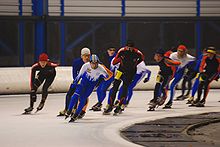 Marathon speed skating in the Netherlands in 2007
Marathon speed skating in the Netherlands in 2007
Skaters skate in a large group, and they skate long distances. When conducted at an ice rink oval, the distance is usually around 40 km, akin to the traditional marathon in running. When skated outdoors on natural ice, the distances can be as long as 200 km. An example of this is the famous Elfstedentocht (Eleven cities tour), which is irregularly held in the Netherlands. Alternative versions of this famous event are sometimes held abroad, e.g., in Finland and Canada.
In cold winters in the Netherlands, a "national championship" skating marathon on natural ice is organized if it meets the minimum requirement of 12-centimetre thickness. For the first time in 13 years, a Dutch championship ice-skating marathon on natural ice was held in January 2009, in the Oostvaardersplassen wetland near Lelystad in the province of Flevoland, an area of land reclaimed in the 1960s. The women competitors competed in 60 kilometres, and the men, 100 kilometres.
An example of a famous marathon outside the Netherlands is the International Big Rideau Lake Speed Skating Marathon in Portland, Ontario, Canada.
Notable skaters
The following is the list of athletes who have won the following competitions at least three times. Those who won two individual Olympic Gold medals are also included.
- Olympic Winter Games
- World Allround Speed Skating Championships
- World Sprint Speed Skating Championships
As its inclusion will place the athletes who have been active before 1996 at a significant disadvantage, World Single Distance Championships are not included as a primary component of the list, though achievements in that competition are noted when applicable. Also see List of long track speed skaters.
Men
Athlete Nation Born-Died Olympics World Allround Championships World Sprint Championships Olympics + World Allround/Sprint Championships World Single Distance Championships Total 


Total 


Total 


Total 


Total 


Total 


Total Eric Heiden  United States
United States1958 5 0 0 5 3 1 0 4 4 0 0 4 12 1 0 13 0 0 0 0 12 1 0 13 Clas Thunberg  Finland
Finland1893-1973 5 1 1 7 5 1 1 7 0 0 0 0 10 2 2 14 0 0 0 0 10 2 2 14 Ivar Ballangrud  Norway
Norway1904-1969 4 2 1 7 4 4 3 11 0 0 0 0 8 6 4 18 0 0 0 0 8 6 4 18 Johann Olav Koss  Norway
Norway1968 4 1 0 5 3 1 1 5 0 0 0 0 7 2 1 10 0 0 0 0 7 2 1 10 Ard Schenk  Netherlands
Netherlands1944 3 1 0 4 3 2 4 9 0 0 0 0 6 3 4 13 0 0 0 0 6 3 4 13 Igor Zhelezovski  Belarus
Belarus1963 0 1 1 2 0 0 0 0 6 0 1 7 6 1 2 9 0 0 0 0 6 1 2 9 Hjalmar Andersen  Norway
Norway1923 3 0 0 3 3 0 0 3 0 0 0 0 6 0 0 6 0 0 0 0 6 0 0 6 Shani Davis  United States
United States1982 2 2 0 4 2 1 1 4 1 0 2 3 5 3 3 11 7 2 1 10 12 5 4 21 Sven Kramer  Netherlands
Netherlands1986 1 1 2 4 4 0 2 6 0 0 0 0 5 1 4 10 9 1 0 10 14 2 4 20 Oscar Mathisen  Norway
Norway1888-1954 0 0 0 0 5 1 0 6 0 0 0 0 5 1 0 6 0 0 0 0 5 1 0 6 Jeremy Wotherspoon  Canada
Canada1976 0 1 0 1 0 0 0 0 4 4 1 9 4 5 1 10 4 3 3 10 8 8 4 20 Rintje Ritsma  Netherlands
Netherlands1970 0 2 4 6 4 2 3 9 0 0 0 0 4 4 7 15 2 2 1 5 6 6 8 20 Knut Johannesen  Norway
Norway1933 2 2 1 5 2 1 0 3 0 0 0 0 4 3 1 8 0 0 0 0 4 3 1 8 Yevgeny Grishin  Soviet Union
Soviet Union1931-2005 4 1 0 5 0 0 2 2 0 0 0 0 4 1 2 7 0 0 0 0 4 1 2 7 Gianni Romme  Netherlands
Netherlands1973 2 1 0 3 2 0 0 2 0 0 0 0 4 1 0 5 7 2 3 12 11 3 3 17 Lee Kyou-Hyuk  South Korea
South Korea1978 0 0 0 0 0 0 0 0 4 0 0 4 4 0 0 4 1 2 1 4 5 2 1 8 Ids Postma  Netherlands
Netherlands1973 1 1 0 2 2 4 1 7 0 0 0 0 3 5 1 9 3 1 0 4 6 6 1 13 Gaétan Boucher  Canada
Canada1958 2 1 1 4 0 0 0 0 1 4 0 5 3 5 1 9 0 0 0 0 3 5 1 9 Kees Verkerk  Netherlands
Netherlands1942 1 3 0 4 2 0 3 5 0 0 0 0 3 3 3 9 0 0 0 0 3 3 3 9 Oleg Goncharenko  Soviet Union
Soviet Union1931-1986 0 0 2 2 3 2 0 5 0 0 0 0 3 2 2 7 0 0 0 0 3 2 2 7 Dan Jansen  United States
United States1965 1 0 0 1 0 0 0 0 2 2 1 5 3 2 1 6 0 0 0 0 3 2 1 6 Michael Staksrud  Norway
Norway1908-1940 0 0 0 0 3 2 1 6 0 0 0 0 3 2 1 6 0 0 0 0 3 2 1 6 Tomas Gustafson  Sweden
Sweden1959 3 1 0 4 0 1 0 1 0 0 0 0 3 2 0 5 0 0 0 0 3 2 0 5 Jochem Uytdehaage  Netherlands
Netherlands1976 2 1 0 3 1 0 0 1 0 0 0 0 3 1 0 4 1 0 0 1 4 1 0 5 Jaap Eden  Netherlands
Netherlands1873-1925 0 0 0 0 3 0 0 3 0 0 0 0 3 0 0 3 0 0 0 0 3 0 0 3 Erhard Keller  West Germany
West Germany1944 2 0 0 2 0 0 0 0 1 0 0 1 3 0 0 3 0 0 0 0 3 0 0 3 Uwe-Jens Mey  Germany
Germany1963 2 1 0 3 0 0 0 0 0 3 0 3 2 4 0 6 0 0 0 0 2 4 0 6 Irving Jaffee  United States
United States1906-1981 2 0 0 2 0 0 0 0 0 0 0 0 2 0 0 2 0 0 0 0 2 0 0 2 Jack Shea  United States
United States1910-2002 2 0 0 2 0 0 0 0 0 0 0 0 2 0 0 2 0 0 0 0 2 0 0 2 Women
Athlete Nation Born-Died Olympics World Allround Championships World Sprint Championships Olympics + World Allround/Sprint Championships World Single Distance Championships Total 


Total 


Total 


Total 


Total 


Total 


Total Karin Enke  East Germany
East Germany1961 3 4 1 8 5 2 0 7 6 2 0 8 14 8 1 23 0 0 0 0 14 8 1 23 Gunda Niemann-Stirnemann  Germany
Germany1966 3 4 1 8 8 0 0 8 0 0 0 0 11 4 1 16 11 3 0 14 22 7 1 30 Bonnie Blair  United States
United States1964 5 0 1 6 0 0 0 0 3 4 2 9 8 4 3 15 0 0 0 0 8 4 3 15 Lidiya Skoblikova  Soviet Union
Soviet Union1939 6 0 0 6 2 1 3 6 0 0 0 0 8 1 3 12 0 0 0 0 8 1 3 12 Anni Friesinger  Germany
Germany1977 3 0 2 5 3 1 1 5 1 2 0 3 7 3 3 13 12 9 1 22 19 12 4 35 Claudia Pechstein  Germany
Germany1972 5 0 0 5 1 8 2 11 0 0 0 0 6 8 2 16 5 12 8 25 11 20 10 41 Monique Garbrecht  Germany
Germany1968 0 1 1 2 0 0 0 0 5 0 0 5 5 1 1 7 4 2 0 6 9 3 1 13 Christa Luding  Germany
Germany1959 2 1 1 4 0 0 0 0 2 2 4 8 4 3 5 12 0 0 0 0 4 3 5 12 Atje Keulen-Deelstra  Netherlands
Netherlands1938 0 1 2 3 4 0 0 4 0 2 1 3 4 3 3 10 0 0 0 0 4 3 3 10 Natalya Petrusyova  Soviet Union
Soviet Union1955 1 0 3 4 2 1 1 4 1 1 1 3 4 2 5 11 0 0 0 0 4 2 5 11 Ireen Wüst  Netherlands
Netherlands1986 2 0 1 3 2 1 2 5 0 1 0 1 4 2 3 9 5 5 0 10 9 7 3 19 Inga Artamonova  Soviet Union
Soviet Union1936-1966 0 0 0 0 4 2 0 6 0 0 0 0 4 2 0 6 0 0 0 0 4 2 0 6 Sheila Young  United States
United States1950 1 1 1 3 0 0 2 2 3 0 0 3 4 1 3 8 0 0 0 0 4 1 3 8 Catriona Le May Doan  Canada
Canada1970 2 0 1 3 0 0 0 0 2 1 1 4 4 1 2 7 3 1 3 7 7 2 5 14 Martina Sáblíková  Czech Republic
Czech Republic1987 2 0 1 3 2 0 1 3 0 0 0 0 4 0 2 6 5 2 0 7 9 2 2 13 Marianne Timmer  Netherlands
Netherlands1974 3 0 0 3 0 0 0 0 1 0 1 2 4 0 1 5 2 2 2 6 6 2 3 11 Andrea Ehrig-Mitscherlich  East Germany
East Germany1960 1 5 1 7 2 4 0 6 0 0 0 0 3 9 1 13 0 0 0 0 3 9 1 13 Cindy Klassen  Canada
Canada1979 1 2 3 6 2 2 1 5 0 1 1 2 3 5 5 13 3 3 4 10 6 8 9 23 Stien Kaiser  Netherlands
Netherlands1938 1 1 2 4 2 4 2 8 0 0 0 0 3 5 4 12 0 0 0 0 3 5 4 12 Valentina Stenina  Soviet Union
Soviet Union1934 0 2 0 2 3 2 1 6 0 0 0 0 3 4 1 8 0 0 0 0 3 4 1 8 Tatyana Averina  Soviet Union
Soviet Union1950-2001 2 0 2 4 1 3 0 4 0 0 0 0 3 3 2 8 0 0 0 0 3 3 2 8 Yvonne van Gennip  Netherlands
Netherlands1964 3 0 0 3 0 1 2 3 0 0 0 0 3 1 2 6 0 0 0 0 3 1 2 6 Maria Isakova  Soviet Union
Soviet Union1918-2011 0 0 0 0 3 0 0 3 0 0 0 0 3 0 0 3 0 0 0 0 3 0 0 0 See also
References
- ^ (Norwegian) Olympiske vinterleker 1924–2006, Åge Dalby, Jan Greve, Per Jorsett, ISBN 8272861623, Akilles forlag 2006, pg. 29
- ^ (Dutch) Wat is Langebaanschaatsen, KNSB.nl
- ^ A short history of world championships from skateresults.com
- ^ (Norwegian) Skøytesportens stjerner, Knut Bjørnsen and Per Jorsett, J. W. Cappelens forlag 1971, pg. 183
- ^ Less orange during the uneven years, from nrc.nl, published 1 July 1999
- ^ (Norwegian) Olympiske vinterleker 1924–2006, Åge Dalby, Jan Greve, Per Jorsett, ISBN 8272861623, Akilles forlag 2006, pg. 33
- ^ (Norwegian) Olympiske vinterleker 1924–2006, Åge Dalby, Jan Greve, Per Jorsett, ISBN 8272861623, Akilles forlag 2006, pg. 78
- ^ (Norwegian) Olympiske vinterleker 1924–2006, Åge Dalby, Jan Greve, Per Jorsett, ISBN 8272861623, Akilles forlag 2006, pg. 52
- ^ (Norwegian) Olympiske vinterleker 1924–2006, Åge Dalby, Jan Greve, Per Jorsett, ISBN 8272861623, Akilles forlag 2006, pg. 252
- ^ (Norwegian) Olympiske vinterleker 1924–2006, Åge Dalby, Jan Greve, Per Jorsett, ISBN 8272861623, Akilles forlag 2006, pg. 230
- ^ Media release from Richmond Olympic Oval, March 2010
- ^ Results available from The German Ice Speed Skating Federation
External links
Categories:- Individual sports
- Skating
- Speed skating
Wikimedia Foundation. 2010.


